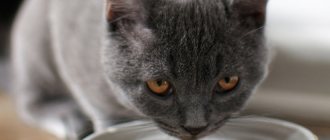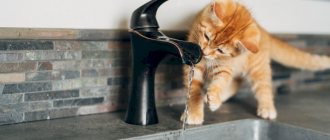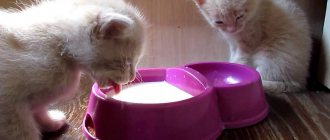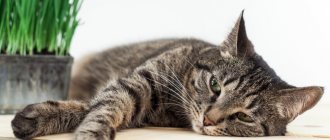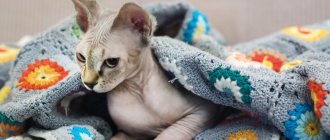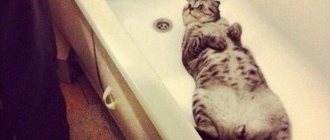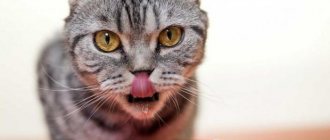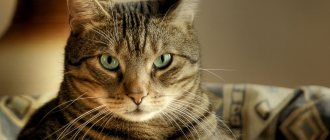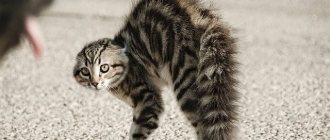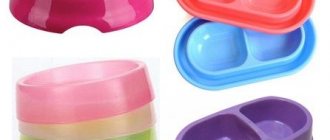This seemingly elementary thing is a cat bowl. But there are pitfalls here too! Choosing the right bowl for your cat can help prevent many nutritional and even health problems.
Pet stores are filled to the ceiling with various cat paraphernalia: this bowl, that bowl, and with pictures, and multi-colored, and expensive, and cheap - however, the owner of the animal is usually guided by his own preferences in the choice. You can’t ask a cat which plate it would be more pleasant to eat from, and what method of serving it prefers. In order to save you as much as possible from the agony of choice, we wrote this article.
Material
Typically, cat bowls are represented by the following materials:
- plastic;
- metal (stainless steel);
- glass;
- porcelain;
- ceramics.
Plastic
Plastic bowls
The most common and inexpensive material for cat bowls. The quality of plastic varies from product to product:
- Cheap material can have an unpleasant odor, and also absorb the smell of food, bend, crack, and even release dangerous toxic substances - phthalates.
- More expensive and high-quality plastic does not have these flaws, and its service life is much longer.
However, be that as it may, in most cases this material has a porous structure in which pathogenic bacteria can multiply, even if you wash the bowl regularly. In particular, the occurrence of acne in cats is associated with plastic bowls. Plastic, especially cheap plastic, is not our option.
Metal bowls
Metal bowls
are much more durable than all others. They usually have a rubberized base that prevents the bowl from sliding on the floor. Stainless steel utensils are absolutely safe for health and easy to clean, but they are also much more expensive than plastic ones.
There is, however, one aspect - dry food can rustle and ring in a metal bowl, which the animal may not like.
Glass, porcelain, ceramics
Ceramic and porcelain bowls
do not have a porous texture, are safe for health, and are easy to clean both by hand and in the dishwasher. In addition, such dishes are available to everyone - probably every house has a couple of saucers or small plates lying around. However:
- such bowls can be accidentally broken (unlike plastic and metal ones);
- they can slide on the floor (as they are usually not equipped with rubberized legs or a base);
- If you preheat food in such a container, you or your pet may accidentally get burned.
Glass bowl
We conclude - plastic is bad, glass, ceramics and porcelain are acceptable, metal is good, but expensive. But material is not everything! The shape of the bowl is of great importance.
Individual product to order
What if you don’t have the time, patience and desire to do it yourself?
Then order an exclusive version of the feeder from the professional craftsmen, which will suit you in all respects:
- Stylish
- Color
- Material
- Size
- Quality
- Reliability
- Environmentally friendly.
Such cat furniture can have only two disadvantages - long production time and high price.
Form
An example of a proper bowl is a flat saucer that does not touch the whiskers.
The most common form of a cat bowl is a more or less deep plate of small diameter with high sides. Sometimes it is wider at the base and seems to taper at the top.
Often two bowls - for food and water - are combined into one. And so the owner, satisfied and proud of himself, having acquired such a bowl, puts delicious food into it with a generous owner’s hand and... watches in disappointment as the cat pulls a piece out of the bowl and eats it on the floor. Why is this happening?
- Many cats prefer to eat as if reclining or sitting on half-bent legs (squatting), and high sides make it difficult to take their favorite position.
- Cats don't like it when the edges of the bowl... touch their whiskers! Vibrissae - tactile organs - are very sensitive, and excessive rough touches irritate the animal and can even provoke a stressful state.
- Flat-faced cat breeds, such as Persians and exotics, experience all of the above difficulties at once: the whiskers, you know, get hurt, and you have to put your whole head into the bowl.
A plastic bowl especially for Persian and British cats has low sides and a ribbed bottom.
Thus, we conclude: the lower the sides and the wider the “mouth” of the bowl, the better. Ideally, this is the most common flat plate or saucer familiar to all of us. The box just opened! However, such a bowl also has a drawback - food can periodically end up “overboard”, so a bowl that is too flat is also bad. But that's not all!
Main varieties
Next, let's try to figure out which shape of bowls is most convenient to use.
Regular
Round and oval bowls are suitable for most cats. They are stable, compact, and you can always choose a stand for them. Without a stand, it is advisable to use models that expand downwards, as if “sinking” into their own sides. For picky pets who do not tolerate contact of their whiskers with dishes, wide rectangular containers are suitable.
Curly
Designer bowls with intricate shapes in the form of fish, stars or birds look original, but are not practical to use. In such dishes, food gets stuck in the corners, the cat cannot get it out of hard-to-reach places, and washing shaped bowls is very inconvenient, especially if the container is small and your hand is large.
Double and triple
Many people find such models convenient, because you can immediately pour water into them and put different food in them. But in practice, it turns out to be the opposite - the food is constantly mixed, gets into the water, and all 2 or 3 compartments have to be washed, even if one is dirty.
Electronic feeders
“Sophisticated” electronic or automatic feeders may seem like a waste of money to some, but you simply can’t do without them:
- if the owners spend a lot of time outside the home and there is no one to feed the pet on time;
- if the cat sometimes stays at home alone for several days (business trips, travel).
As a rule, such feeders are equipped with dispensers and timers, thanks to which the pet follows its regime, receiving food at certain intervals and in the right quantity. The device can operate either from the mains or from a battery.
Do you need coasters and mats?
Examples of stands - wooden, metal and plastic
The range of cat gadgets is full of different stands, ranging from plastic to wooden. Their purpose is to give the bowls stability, to please the owner's eye aesthetically, and to prevent food and crumbs from spilling on the floor. Some of them are attached to the wall, leaving space on the floor free. But as practice shows, many cats don’t like them. Why?
- Metal stands again prevent the cat from adopting a “half-bent” position; even if they are adjustable in height, they will still have to be lowered to the floor as much as possible - why not just do without them?
- Wide stands in the form of a tray or stands with niches into which bowls are inserted are also not liked by everyone, since they either raise the bowls higher or have a fairly large area, but limited by the sides, which makes it difficult for the animal to access the bowl from different sides.
- Rugs can have an unpleasant odor or scare the cat away from the bowl, since for the animal it is an incomprehensible substance that does not want to get its paws dirty. Although the item itself is useful - rugs can also absorb spilled water, some of them even have sensors that will prevent the robot vacuum cleaner from crawling into the bowls.
Silicone bowl mats
are suitable for your pet if he prefers to eat while sitting or standing. If you want to keep the floor clean, but the cat does not perceive a beautiful stand or rug, you will have to accept it or use regular paper towels, changing them from time to time. Cheap and cheerful!
Useful homemade products
Murka owners demonstrate skill and design abilities, and use the ingenuity and artistic taste of all family members.
For example:
- There is a box made of thick corrugated cardboard. In this case, you can make a stand out of cardboard. Cut three identical rectangles from flat sheets - this will be the top and main part of the stand. Choose the size of the base taking into account the diameter of the cat's bowl.
Glue the blanks together. Then wrap it with self-adhesive film. Glue wooden cubes instead of legs. Or attach the craft to the wall using corner brackets. The cardboard stand or shelf for cat dishes is ready. - There is a piece of furniture board sitting idle in the closet. Make a wooden table for your cat from it yourself.
- Of course, this also requires a tool.
- And to make the craft look no worse than the store-bought one, try and apply creative skills:
- Make a drawing on paper or directly draw it on chipboard;
- Cut out blanks from furniture panels;
- Assemble the product using self-tapping screws and a screwdriver;
And then wood putty, sandpaper, and moisture-resistant paint in the color you have in mind will help. Patience and inspiration will also come in handy.
Water bowl
The shape of the water bowl is very important, because getting a cat to drink water again is not an easy task. But in reality it's simple:
- The water bowl should have a very wide mouth and low sides.
- The container itself should not be very small - focus on a soup plate or small basin.
- It is better to purchase several of these “basins” and place them in accessible places (but away from electrical appliances).
You can also pay attention to automatic fountains - constantly circulating water attracts cats more than just a bowl of water. A variety of shapes and materials will allow you to purchase a fountain to suit every taste and budget.
Examples of industrial products
- The snow-white, rectangular table of the Ferplast brand is made of wood. The originality of the set is given by two porcelain plates of white and black square shape. This set can be a wonderful gift for a cute little cat or dog. Will serve as a successful addition to the apartment interior. More details>>>
- Japan Premium Pet, an online pet supply store from Japan, offers a wooden anatomical table for cats and dogs, complete with a rubber mat. Any utensils with food on this coating will not slip. And the height of the table is recommended by Japanese veterinarians: this makes it more convenient for pets to swallow food without trapping excess air. View>>>
- The KeramikArt model is made of metal. The product set includes two round ceramic plates with a rubberized bottom. Bright colors of dishes create a joyful mood and add an accent to the interior of the apartment. Check the price>>>
Gadget bowls
Automatic feeders should be selected according to the following principle:
- not very high sides;
- wide base;
- high-quality plastic (after all, as a rule, such feeders are made of plastic).
There are different types of automatic feeders:
- Some work on the principle of communicating vessels - as soon as the bowl is empty, the container throws out a portion of food.
- More advanced models run on batteries - recently one of our subscribers shared her experience of purchasing such an automatic feeder for six feedings.
There are also interactive feeders, or food puzzles. They are great for animals with eating disorders:
- swallowing food too quickly without biting the croquettes;
- aerophagia;
- vomiting of undigested food and so on.
What to choose?
As you can see, the choice of specialized dishes for feeding purring pets is very large, but it is quite difficult to say exactly which model you should choose, because everything depends solely on the preferences of your pet.
Generally speaking, it is better to purchase a set of two ceramic plates of different depths and complement them with a non-slip mat. Well, for pets who need a diet or small meals, an automatic feeder will be the best choice. It can also be installed for those who do not allow their owners to get enough sleep on a weekend morning.
